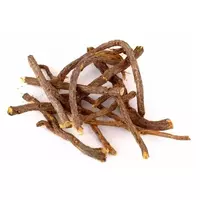Licorice root

The Licorice species includes a fairly extensive list of perennial herbal plants that grow in Eurasia, Africa, Australia and the Americas. A subspecies of the plant Licorice naked or Licorice (Glycyrrhíza glabra) has long been used in cooking and medicine. The most popular is the root of the plant, which is used as a healing agent. The distinctive taste and beneficial properties of licorice root have been known to people since ancient times.
Licorice root composition
Researchers have found documentary evidence that the licorice plant was used as a means of Chinese traditional medicine five thousand years ago. The useful properties of licorice root, like the plant itself, were carefully described in the famous ancient Chinese treatise "On Herbs. " The chemical composition of licorice root has a decisive effect on the taste, as well as useful qualities of the product.
Licorice root contains tannins, amino acids of natural origin, as well as natural sugar-containing compounds of glucose, sucrose, maltose and fructose. In addition, liquorice is rich in the content of essential oils, resins, coumarins, steroids, as well as flavonides, alkaloids and fatty acids.
Licorice root benefits
The benefits of licorice root lie in the chemical composition of the plant, which is a generally recognized treasure trove of vitamins and useful biologically active substances. Licorice root is used in pharmacological industry in production of medicinal products. For example, the benefits of licorice root in the treatment of diseases of the upper respiratory tract have been proven.
We think many of us have seen in pharmacies or used licorice root-based cough syrups ourselves. In addition, licorice root is used in the treatment of diseases of the duodenum, neurodermatitis, rheumatism, gout, eczema and bronchial asthma. Licorice root is used as a natural sugar substitute and is used in the nutrition of patients with diabetes mellitus. Also, licorice root is an active substance that is included in vitamin oxygen cocktails.
In recipes for traditional medicine, licorice root occupies a special place. Liquorice is used to prepare infusions and healing preparations. Decoction of licorice root on milk helps with whooping cough and hypertension, and powder from the rhizome of the plant is used as a prevention of colds and viral diseases, as well as to strengthen immunity. Licorice really belongs to medicinal and certainly useful plants. However, licorice root has its own contraindications and risk groups.
Harm to licorice root
Licorice root can be harmful if you take plant-based drugs without medical advice or indications. Licorice root should not be eaten for hypertension, kidney disease, and hypoglycemia. Doctors advise to exclude licorice root from the diet of obese patients, as well as women during pregnancy and breastfeeding. It is believed that harm to licorice root can result in severe allergic reactions.
licorice root 375 kCal
Energy value of licorice root (Ratio of proteins, fats, carbohydrates - ju):
Proteins: 0 g (~ 0 kCal)
Fats: 0.05 g (~ 0 kCal)
Carbohydrates: 93.55 g (~ 374 kCal)
Energy ratio (b | y): 0% | 0% | 100%
 Español
Español Français
Français Português
Português Русский
Русский 简体中文
简体中文 繁體中文
繁體中文 日本語
日本語 한국어
한국어 العربية
العربية Türkçe
Türkçe Қазақ
Қазақ Deutsch
Deutsch Italiano
Italiano Українська
Українська
